Driver's door central locking not working. How to determine the cause of a malfunction of the central lock. Why is the central lock not working?

On the VAZ-2114, it is an excellent device with which you can open or close all doors with a single movement vehicle. Over time, a situation arises when the car stops closing with the help of the central lock, or the closure occurs every other time. In this case, it can be judged that the device is out of order.
Causes of the malfunction
There are many reasons why the central lock on the VAZ-2114 stops working stably. All existing causes of failure can be divided into two subgroups: climatic impact and technical failure. In the first case, the lock starts to work unstable due to the influence of the climate, that is, due to very low temperatures, as a result of which not only the lock, but also other systems can freeze. Or, as a result of heavy rains, water got into the central lock on the VAZ-2114. Among the technical reasons, it should be noted incorrect installation of the device on a car or wrong setting his works. But sometimes the device does not work due to long-term operation, which leads some elements to natural wear and tear. Also, the problem may be the use of low-quality devices.
Principle of operation
How is management central lock on VAZ-2114? The algorithm of the central locking action is that the control impulse arrives at a certain point, as a result of which one relay with power contacts is activated. In one case, the car is locked, in the other - vice versa. The central locking activators are connected to the 30th contact of the relay, and through the closed 87th contact, the mass acts on both outputs of the activator. If one or another relay is triggered, then the 30th contact will be connected to the positive, and as a result, a temporary voltage will be applied to the activator, which will set the rod in motion, which will either open or close the door. 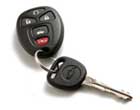 Taking into account the fact that all activators are connected to the central locking system in parallel, one action will be the same for all doors. Installed locks on cars can be electric or pneumatic. The electric central lock consists of mechanisms with a single motor, the second, in turn, includes a compressor, tubes and a control panel.
Taking into account the fact that all activators are connected to the central locking system in parallel, one action will be the same for all doors. Installed locks on cars can be electric or pneumatic. The electric central lock consists of mechanisms with a single motor, the second, in turn, includes a compressor, tubes and a control panel.
Expert opinions
Many experts who have encountered the problem that the central lock on the VAZ-2114 does not work argue that all troubles with the device should be divided into certain categories. Below we will look at each of them.
- Complete device failure.
- Partial failure of the lock.
- Malfunctions resulting from mechanical, electrical or other defects.
If there is a problem with the central lock, the car owner must independently determine which of the above categories the breakdown belongs to. Therefore, the repair of a malfunction should not begin with the analysis of a particular unit - it is enough to conduct a thorough diagnosis of the equipment. Thanks to the diagnostics carried out, the motorist will not only reduce the time to find and solve the problem, but also reduce the monetary costs of repairs. 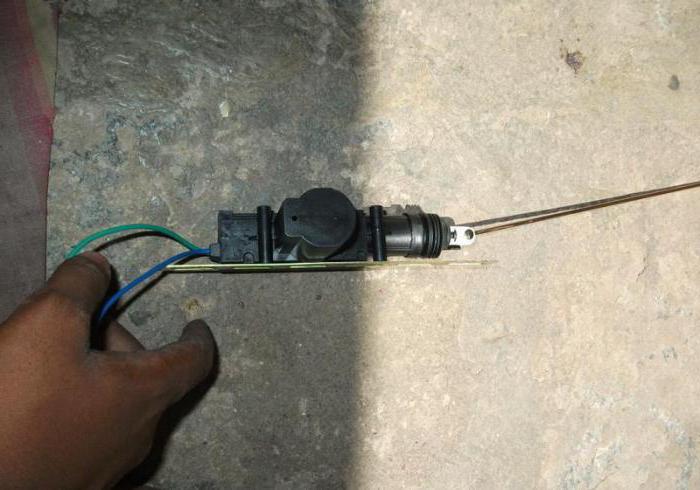 Firstly, the central door lock on the VAZ-2114 works regardless of engine operation or ignition. The main thing for the central lock is the presence of a working on-board network. The correctness of the BS is correct connection vehicle power terminals to the battery. Experts call the simplest cause of the malfunction too thick walls of the door tongues, which cannot freely walk through the skin. As a result, the activator is simply unable to close the doors, while reproducing the clicks of the completed work. You can check in a simple way- just unscrew the locks from the doors and close the car. If all the doors close at once, you will have to buy new latches with a smaller outer diameter.
Firstly, the central door lock on the VAZ-2114 works regardless of engine operation or ignition. The main thing for the central lock is the presence of a working on-board network. The correctness of the BS is correct connection vehicle power terminals to the battery. Experts call the simplest cause of the malfunction too thick walls of the door tongues, which cannot freely walk through the skin. As a result, the activator is simply unable to close the doors, while reproducing the clicks of the completed work. You can check in a simple way- just unscrew the locks from the doors and close the car. If all the doors close at once, you will have to buy new latches with a smaller outer diameter.
Diagnosis of alarm malfunction
The central lock control activator is installed in the driver's door. As soon as this drive is triggered, a signal is sent through the channels of the circuit between the other activators, according to which the desired action occurs. When an alarm is installed on the car, the performance test should begin with it. To do this, you need to check the closure both with a key and with a key fob. If the car closes completely from the first, but not from the second, then the problem lies in the electrical signaling circuit or in the control circuit. It happens that the simplest reason for not locking the car from the key fob is a weak charge used in the battery. 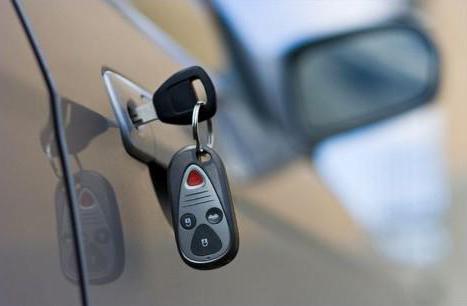 It happens that when manual way central locking does not work. If a vacuum central locking is used, then during a manual check there will be no sound of a running compressor. With an electric central lock, characteristic clicks that the relay emits will be heard. However, the buttons on all doors will remain in the same position. Most often, domestic cars use electrical systems central lock. In such cases, the VAZ-2114 central lock fuse probably failed. Depending on the connection circuit used, more than one fuse may need to be replaced. On this repair can be completed quickly.
It happens that when manual way central locking does not work. If a vacuum central locking is used, then during a manual check there will be no sound of a running compressor. With an electric central lock, characteristic clicks that the relay emits will be heard. However, the buttons on all doors will remain in the same position. Most often, domestic cars use electrical systems central lock. In such cases, the VAZ-2114 central lock fuse probably failed. Depending on the connection circuit used, more than one fuse may need to be replaced. On this repair can be completed quickly.
Blown fuse
It may happen that the replaced element quickly burns out. When using a central lock, the fuse may burn out due to a short circuit or overload. The latter occurs when carrying out any actions on frozen locks using a key fob, and not manual opening doors. 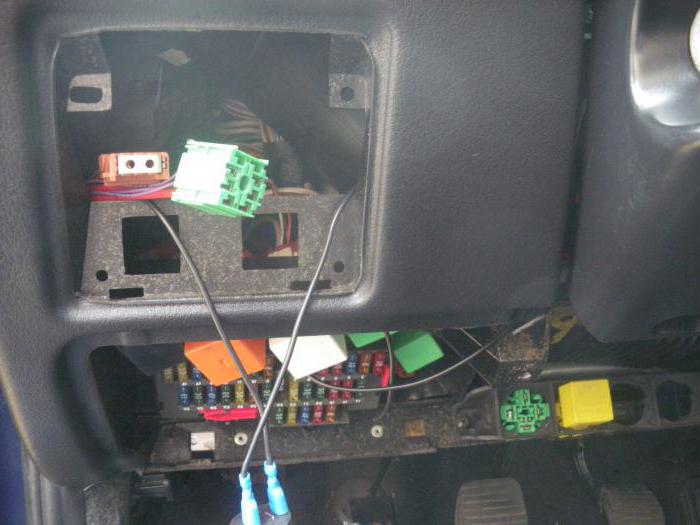 If it is warm outside and there is no question of frozen locks or frozen grease, then the matter lies in a short circuit. In case of a short circuit, you need to look for the cause, the reason may be a broken wire or a poor connection due to oxidized contacts. In this case, the fuse remains intact, but the signal is not transmitted due to the lack of a control circuit. The activator limit switch may also be broken.
If it is warm outside and there is no question of frozen locks or frozen grease, then the matter lies in a short circuit. In case of a short circuit, you need to look for the cause, the reason may be a broken wire or a poor connection due to oxidized contacts. In this case, the fuse remains intact, but the signal is not transmitted due to the lack of a control circuit. The activator limit switch may also be broken.
Elimination of broken wires
As a rule, most often the wires break off or break off in the corrugation of the door. This is due to the fact that the door is constantly opening or closing, and the wire insulation is quite thin. To eliminate the malfunction of a broken wire from the rubber corrugation of the door, it is necessary to slowly pull out one wire at a time, which fit or depart from the central lock for power or control. Broken wires can easily be pulled out of the total mass. You can connect a break using the simplest connection with the “father-mother” terminals. If the break occurred elsewhere, it is necessary to test the entire wiring with a multimeter. When checking, it is worth remembering that voltage will be present on one wire only at the moment of opening, and on the other - when the central lock is closed.
The VAZ-2114 central locking unit burned out
One of the reasons for the breakdown may be a malfunction of the central locking unit. To carry out the necessary diagnostics, it is enough to use a multimeter and check the voltage of the contacts that account for the connection of the activators of the remaining doors. 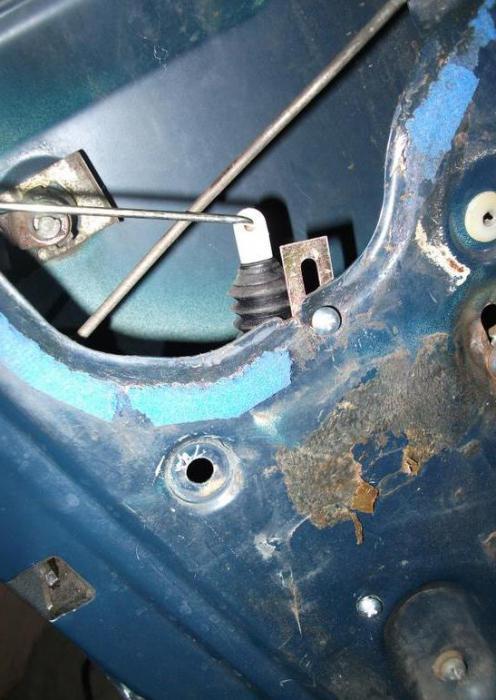 When checking other doors, the main drive (the one installed on the driver's door) needs to unlock or lock the lock. Simply put, apply current to the contacts of the block. What to do if the central lock on the VAZ-2114 fails? In this case, it must be replaced with a new one. But it can be restored.
When checking other doors, the main drive (the one installed on the driver's door) needs to unlock or lock the lock. Simply put, apply current to the contacts of the block. What to do if the central lock on the VAZ-2114 fails? In this case, it must be replaced with a new one. But it can be restored.
Repair of electric central lock
Central lock on VAZ-2114 of this type after a while it starts to work intermittently. They will be associated with temperature fluctuations. Most often, unstable operation of the electric central lock will be observed at low temperatures or high humidity air, that is, in the autumn-winter period. At first, the mechanisms will wedge slightly, then opening or closing will not occur at all. Most often, this problem occurs on domestic cars with a pre-installed central lock from the manufacturer. It is better to replace the locks with solenoids installed at the factory with central locks with motors, which will be more reliable. 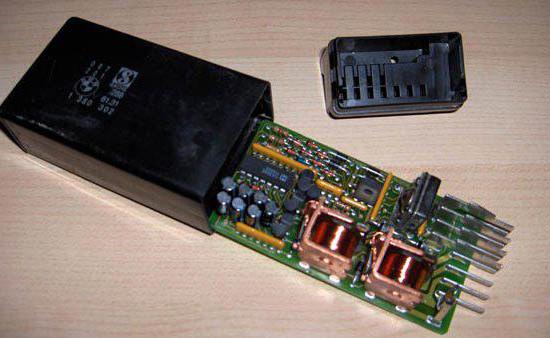 If the drive of one door does not work, the circuit to this door should be checked. If there is no open circuit, then the problem may lie in a malfunction of the switch-on relay or a breakdown in the activator control board. Sometimes the winding of the solenoid or motor may burn out, or the drive gear may wear out. In this case, it may be necessary to replace the auxiliary drive of the central locking door.
If the drive of one door does not work, the circuit to this door should be checked. If there is no open circuit, then the problem may lie in a malfunction of the switch-on relay or a breakdown in the activator control board. Sometimes the winding of the solenoid or motor may burn out, or the drive gear may wear out. In this case, it may be necessary to replace the auxiliary drive of the central locking door.
CZ drive failure
If all the wiring is in good condition, then it also happens that the main activator breaks down, which closes the central lock on the VAZ-2114. To solve the problem, it is enough to purchase a new activator main door. Just remember that you should buy a lock drive that has 5 wires, not 2. Since the five-wire is placed on the control door, and the two-wire - only on the controlled part.
So, we examined the main malfunctions that happen to the central lock on domestic Samara-2 cars.
There are a lot of reasons why the central locking of a car may fail or stop working stably. Sometimes weather is to blame for malfunctions, namely too high humidity, excessive low temperatures and similar features of the climate. But sometimes problems arise due to incorrect installation the lock itself, its incorrect adjustment, as well as normal wear and tear due to long-term operation.
1. Localization of malfunctions of the central lock
Experts conditionally divide all the problems that may occur with the central lock into several groups:
1) Full or partial failure;
2) The lock works, but with malfunctions, which are caused by electrical or mechanical defects, or due to damage.
If the central locking of your car is acting up, then try to determine which category the defect belongs to. Repair should begin not with the analysis of any parts, but with the diagnosis of equipment, which will significantly reduce the time for repairs, and sometimes the financial costs of this event.
The operation of the central lock should not depend on the operation of the engine, as well as on whether the ignition is turned off or on. The most important thing is that the on-board network works, that is, the power terminals must be connected to the battery.
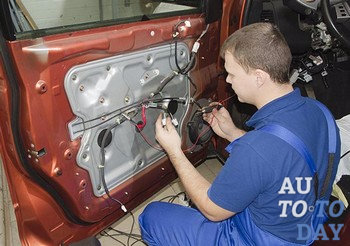 The whole system is formed by switches connecting the wires and the drive, on which the type of the central lock will depend. The central lock can be electric, while the drive will also be electric, that is, presented in the form of solenoids or mechanisms with a motor. If the central lock is pneumatic, that is, vacuum, then it will have a vacuum drive, while the drive will be formed from the control board, compressor and tubes. Often, actuators are called activators or actuators. The control drive is mounted in the door on the driver's side, and sometimes on the passenger side. If this drive is triggered, then an electrical signal is sent through special wires, which will open or close the remaining doors.
The whole system is formed by switches connecting the wires and the drive, on which the type of the central lock will depend. The central lock can be electric, while the drive will also be electric, that is, presented in the form of solenoids or mechanisms with a motor. If the central lock is pneumatic, that is, vacuum, then it will have a vacuum drive, while the drive will be formed from the control board, compressor and tubes. Often, actuators are called activators or actuators. The control drive is mounted in the door on the driver's side, and sometimes on the passenger side. If this drive is triggered, then an electrical signal is sent through special wires, which will open or close the remaining doors.
If the car has an alarm, then the repair must begin with its testing. If, when using a portable alarm panel, the central lock does not respond, then you need to check the operation of the lock from the button and key, which are responsible for opening and closing the door on the driver's side. If at manual control the lock works, then the problem lies in the malfunctions of the control and electrical circuits of the alarm itself. First of all, you need to check the battery, which is in remote control. She may be torn.
2. If the lock does not work at all or partially
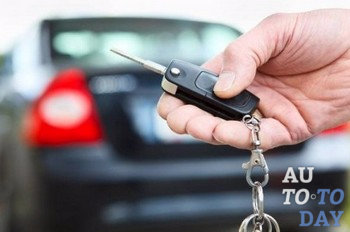 If after manual check operation of the central lock, it still does not work, then you need to determine what the problem is, that is, specify the nature of the manifestation of the defect. If the vacuum central lock completely fails, then you will not hear how the compressor works. In the case of electric central locking, you will hear weak clicks that the relay will emit, and the buttons for self-opening will not work on all doors. If this is the case, then you need to check and, if necessary, install a new fuse for the central locking circuits. It may be necessary to change a few fuses, depending on the electrical circuit of the machine.
If after manual check operation of the central lock, it still does not work, then you need to determine what the problem is, that is, specify the nature of the manifestation of the defect. If the vacuum central lock completely fails, then you will not hear how the compressor works. In the case of electric central locking, you will hear weak clicks that the relay will emit, and the buttons for self-opening will not work on all doors. If this is the case, then you need to check and, if necessary, install a new fuse for the central locking circuits. It may be necessary to change a few fuses, depending on the electrical circuit of the machine.
There is a possibility that this will be enough to normalize the work, and the repair will end there. If at the moment when the central locking is activated, one of the fuses burns out, then this indicates that somewhere in the circuit that this fuse protects, a short circuit. In this case, you need to look for the reason why the closure occurs. If all the fuses are in order, but manually opening the central lock does not work, then the reasons may be as follows:
1) The supply wires may have broken, or the contacts are not connected to the terminals due to oxidation, so there is no voltage at the input of the driver's door activator, that is, the control signal cannot be transmitted by the drive to the other doors. There is simply nothing to transmit the signal with;
2) The limit switch of the driver's door activator has broken, or the wires that extend from the control terminals have broken, or there is too little contact on the terminals, that is, there is no control signal.
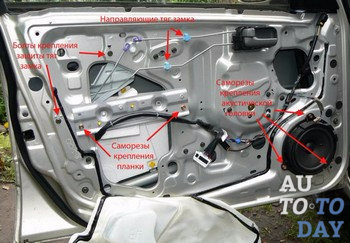 Repair work should begin with checking the presence or absence of power and wire control signals at the time the central lock is activated, that is, you need to check if there is voltage at the corresponding terminals. Then you will need to check the wires for quality and integrity. At the very end, you need to check the limit switch, which will need to be repaired or completely replaced, if necessary. The switch in the case of electric central locks is always located inside the drive.
Repair work should begin with checking the presence or absence of power and wire control signals at the time the central lock is activated, that is, you need to check if there is voltage at the corresponding terminals. Then you will need to check the wires for quality and integrity. At the very end, you need to check the limit switch, which will need to be repaired or completely replaced, if necessary. The switch in the case of electric central locks is always located inside the drive.
The central lock may not work if there is a breakdown in electronic circuit car alarms, and in the case of a vacuum central lock, the compressor board may also be broken. It is necessary to check and repair them at the stage of completion of diagnostic work. If the central locking still responds, then this is a case of a partial defect, that is, you can hear how the compressor of the vacuum central locking works, or you can hear the clicks of the relay at the electric lock.
Manual door buttons may or may not work on every door. They can also quickly switch from the "closed" to the "open" position and vice versa. Such defects can occur due to impaired fixation of the fasteners of the rod that goes from the drive to the locking mechanism. This can happen in the doors both on the driver's side in case of poor operation of all activators, and in other doors if the opening and closing process is disturbed in them.
3. Repair of partial failures of the vacuum central lock
Often, such breakdowns of the central lock are accompanied by atypically long compressor operation (15 - 20 s, or even more):
1) Until the pump stops working, the car doors open and close with a central lock;
2) All doors have either opened or closed, or some kind of lock has not worked, and the compressor is buzzing until it is turned off by the protection.
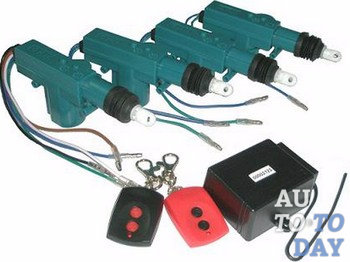 In the first case, a breakdown may occur due to too much condensate or due to breakdowns that are associated with the contacts of the activator switch. That is, there is voltage from the drive through both control wires to the pump board, there is a “+” goes to both closing and opening, which is why the compressor either pumps out or pumps air. In this case, you will need to check the switch, and if necessary, replace or repair it. There can be several reasons for the failure of the second case:
In the first case, a breakdown may occur due to too much condensate or due to breakdowns that are associated with the contacts of the activator switch. That is, there is voltage from the drive through both control wires to the pump board, there is a “+” goes to both closing and opening, which is why the compressor either pumps out or pumps air. In this case, you will need to check the switch, and if necessary, replace or repair it. There can be several reasons for the failure of the second case:
1) Vacuum line tubes leaking;
2) The signal to open or close the lock does not reach the compressor control board from the limit switch of the activator of one or more doors. The pump continues to work;
3) Signals to open or close the locks are not received by the compressor, despite the fact that they reach it.
In the first case you need to first check the line to the door where the drive does not work. You can find the area where there is damage by the characteristic hiss of air. Pipes that are damaged must be replaced. In the case of the integrity of the hoses, the problem is not the tightness of one of the drives. Often, the membrane is damaged on one of them, or the wire itself breaks. If you could not find the necessary membranes or actuator, you will have to buy the door lock itself.
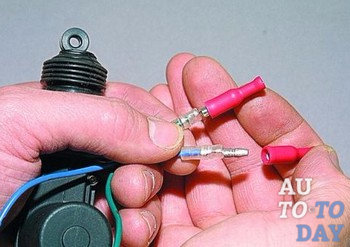 If the problem falls under second case, then repair work you need to start by diagnosing the electrical circuits going from the door actuators to the control board, for the presence of voltage on the corresponding wire. To do this, you can simply compare the state of all circuits from all drives. Most likely, the wrong signal comes from a single wire, and the voltage on the bundle of wires in which there is this “broken” one will not be the same as on conductors from other bundles. Then you will need to find the place of the open circuit and fix it. Often, damage is in the area of door corrugations. In the case of the integrity of the wires, the cause of the malfunction must be sought in the limit switch, which will either have to be repaired or replaced.
If the problem falls under second case, then repair work you need to start by diagnosing the electrical circuits going from the door actuators to the control board, for the presence of voltage on the corresponding wire. To do this, you can simply compare the state of all circuits from all drives. Most likely, the wrong signal comes from a single wire, and the voltage on the bundle of wires in which there is this “broken” one will not be the same as on conductors from other bundles. Then you will need to find the place of the open circuit and fix it. Often, damage is in the area of door corrugations. In the case of the integrity of the wires, the cause of the malfunction must be sought in the limit switch, which will either have to be repaired or replaced.
In the third case it will be necessary to disassemble the compressor unit and clean the contacts of the terminals of the pneumatic alarm sensor for opening and closing. Most likely, the terminals are oxidized. If, after such a repair, the lock still does not work, then you should check the control board circuit. It will need to be repaired.
4. Electric central lock repair
 Central locks with domestic-made solenoids, a few years after the start of use, begin to act up due to temperature fluctuations, and they are especially badly affected by cold along with high humidity, which is typical for autumn and spring. First, the solenoids wedged, and then they may completely refuse to open and close the locks. Often, this situation is typical for cars, the central locking of which was installed at the factory. It would be better to change them to drives with a motor, but you can still try to carry out repair work. If the activator of one or more doors does not work at all or works only partially, then this indicates that:
Central locks with domestic-made solenoids, a few years after the start of use, begin to act up due to temperature fluctuations, and they are especially badly affected by cold along with high humidity, which is typical for autumn and spring. First, the solenoids wedged, and then they may completely refuse to open and close the locks. Often, this situation is typical for cars, the central locking of which was installed at the factory. It would be better to change them to drives with a motor, but you can still try to carry out repair work. If the activator of one or more doors does not work at all or works only partially, then this indicates that:
1) An open or broken contact has occurred in the power circuit going from the activator switch from the driver's door to the power relay (directly or through the control board) and then to the idle drive;
2) The relay is out of order;
3) The control board is broken;
4) Broken wires or broken contact on the motor terminals or solenoids inside the activator;
5) The gears of the activator with the motor or its moving parts are worn out;
6) Motor winding or solenoid coil burnt out.
You need to start the repair by checking the voltage supply to the drive that does not work. Voltage must be on one wire at the moment the close function is activated. At the moment of opening, the voltage on this wire should disappear, and on the other, on the contrary, it should appear. Then, based on the results of the diagnostics, it will be necessary to check either the activator itself and repair / change it, or the circuit that comes from it, in “pieces”, then this is the area before the relay along with the control board, then the relay itself and the wires after it . Damaged areas will need to be repaired. Most often, in the central locking system of a car, the wires in the corrugation between the body and the door are torn.
Subscribe to our feeds
Central locking makes life easier for the driver by locking and unlocking all car doors at once. That is why failures in his work are perceived by the owner so painfully.
The principle of operation and the device of the central lock
When the key is turned in the driver's door lock, a microswitch is activated, which sends a signal first to the door control unit, and then to the central unit, from where control signals are sent to the control units of the remaining doors (trunk lid and fuel hatch).
 The door lock actuator (actuator), having received a signal from door block control, includes an electric motor with a gearbox. rotational movement the electric motor is converted into reciprocating motion of the lock rod.
The door lock actuator (actuator), having received a signal from door block control, includes an electric motor with a gearbox. rotational movement the electric motor is converted into reciprocating motion of the lock rod.
Thus, when the driver's door is opened with the key, the locks of all other car doors are unlocked. When locking the driver's door with the key, everything happens exactly the opposite.
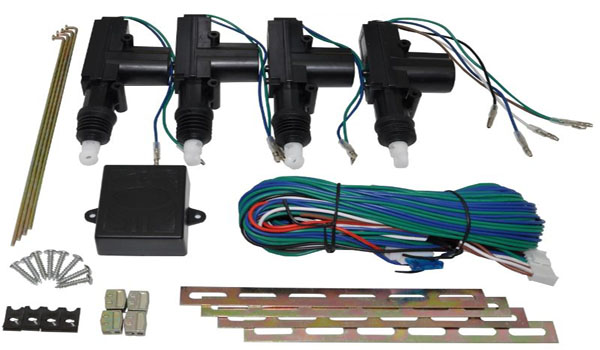 If there is a special button on the ignition key, unlocking and locking the car doors can be performed remotely. The indisputable convenience of the central lock is that, simultaneously with remote locking / unlocking door locks the car alarm is activated/deactivated. By the way, the central lock is perfectly combined with.
If there is a special button on the ignition key, unlocking and locking the car doors can be performed remotely. The indisputable convenience of the central lock is that, simultaneously with remote locking / unlocking door locks the car alarm is activated/deactivated. By the way, the central lock is perfectly combined with.
Failure of the control panel
In the case when the central locking does not respond to pressing the button on the alarm control key fob, try closing the door on the driver's side with the key. If at the same time the central locking works, the cause of the malfunction is in the portable remote control.
The battery can simply run out in it, but the electronic module of the device also fails.
Fuse blown
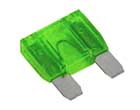 Start troubleshooting the central lock by checking the fuse through which the device is connected to the power circuit.
Start troubleshooting the central lock by checking the fuse through which the device is connected to the power circuit.
There are only two reasons for a burnout: a short circuit and an overload of the circuit. In the first case, look for the cause of the short circuit in electrical wiring. In the second case, overloads are usually caused by increased current consumption by the motor of one of the actuators.
The "appetite" of the actuator motor increases if, due to or incorrect adjustment of the thrust, the force required to lock or unlock the lock increases. To find the culprit of overloads, turn off each of the actuators from the connectors in turn.
chain break
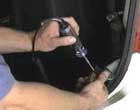 If the integrity of the wires is violated, the central lock either does not show any signs of life at all, or works unstably, intermittently. Most often, a break in the wires occurs in places where they are constantly bent. Such a place is the transition of the wire from the pillar to the door.
If the integrity of the wires is violated, the central lock either does not show any signs of life at all, or works unstably, intermittently. Most often, a break in the wires occurs in places where they are constantly bent. Such a place is the transition of the wire from the pillar to the door.
To find a broken wire, remove one end of the corrugation from the mount, along which the wires are connected to the door, and then pull each of the wires towards you one by one. A broken wire will quite easily succumb to the pulling force and come out.
Failure of the control unit
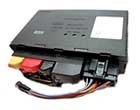 Both the control unit located in the driver's door and the central control unit may be faulty.
Both the control unit located in the driver's door and the central control unit may be faulty.
For diagnostics, you need a tester. Check the presence of voltage first on the conductors of the control line, and then the power line.
Apply current in two ways: by turning the key in the driver's door lock and pressing the button on the portable control panel. Without electrical circuit it will be extremely difficult to determine the necessary contacts for testing the central lock.
Actuator failure
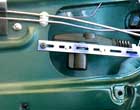 There are quite a few reasons for the inoperability of the actuators: oxidation or damage to the contacts, engine failure, wear and skew of the gears of the gearbox, and violation of the fixation of the fastening of the rods.
There are quite a few reasons for the inoperability of the actuators: oxidation or damage to the contacts, engine failure, wear and skew of the gears of the gearbox, and violation of the fixation of the fastening of the rods.
Much less often, but the cause of interruptions in the operation of the central lock may be contamination of the lock mechanisms or getting into them foreign objects. A lot of problems can be created by condensation that has accumulated inside the door.
Before you give the car into the caring hands of car service workers or decide to replace the central lock with a new device, try to determine the cause of its malfunction yourself.
Good luck to you! Not a nail, not a wand!
Comfort, well, is it or well it? In fact, all car owners are concerned about the comfort system, and this is understandable, because it is always nice when all the buttons in your car work properly, open and close windows and doors easily and simply, recline the seat backs, the fuel tank cap does not cause any problems, and The trunk opens with the push of a button. Even better when the car starts even without a key. Beauty, and only, and comfort for many, begins with the mechanism of the so-called "central lock", and when the central lock does not work, all beauty disappears. For those who for some reason do not know what kind of animal it is and how it works, a few words about the CZ.
Central locking device
The “central locking” mechanism only sounds unambiguous; in practice, it includes several blocks, sensors and actuators with an executive function. The entire system of this mechanism can be controlled remotely using a remote control, which has a built-in radio transmitter that transmits a signal to the receiving antenna of the main control device.
The input sensors of the "central locking" mechanism are microswitches, as well as limit switches for door locks. For fixation current position microswitches are used in the design of the car door. From the electronic control unit, signals are sent to all switches, pre-processed and sent to the central unit. After receiving the signal, the central unit processes it and redirects it to the front door control units, to the executive locking mechanisms rear doors, on the lock of the fuel tank cap, as well as on the trunk lock.
Central locking is able to function regardless of the operation of the car engine, that is, it does not matter whether the ignition is on or not, the central locking from the key should work. If the signal stops coming from the remote central system, the first thing to do is to check the battery on the key fob, and, if necessary, notice it with a new one.
Central locking does not work
What to do if replacing the battery in the remote control did not help, and the "central lock" refuses to work? There is a simple and fairly "advanced" way to fix things. Firstly, it is worth understanding what does not work for you, namely the remote opening of the doors, or the mechanism itself! Secondly, to understand why this happened:
First option - the car does not recognize its native key, and this is the simplest, you can fix it by simply "writing" the key again. For this you need:
Get into the car interior, lock all the doors with the button on the driver's door. Make sure your car doors are closed. Unlock, open only one driver's door, insert the ignition key into the lock but do not turn it, then pull it out. Leaving the driver's door open, use the button to lock it and press the central lock exactly five times (yes, it's fun - Lock -Unlock, Lock -Unlock, and so on, remember 5 (!) Times). Last time press "Unlock" and insert the ignition key in the lock to the "ON" position, then pull it out. Next, all the door locks of your car should open, then close again, so the central locking began the lock / unlock cycle.
It's great if everything worked out the first time! But it happens that a second take will be needed, for this you need:
- press the "Lock" and "Unlock" buttons on the key at the same time and hold them for no more than two seconds, then release;
- press the "Lock" button for just a second and door locks should be blocked, because by this moment the buttons have already been registered, and
- after pressing the “Lock” button, its command is executed - blocking.
The second option means key transmitter malfunction, this will help to find out the indicator on it, which should blink when the buttons are pressed. If it turns out to blink, then you have to go to the store to buy a new one. In order not to walk in this case, I advise you to order a spare key, especially since big money it's not worth it.
The third, and most unpleasant option - remote key receiver failure. In this case, the central lock stopped working for a reason, and you can’t do without looking for a reason. You can start by checking the power supply, and this can only be done with a known-good receiver, in other words, go to a competent electronics engineer who understands this.
Troubleshooting yourself
If a trip to an auto-electronic engineer is postponed for some reason, then you can try to look for the cause of the malfunction yourself. Perhaps the alarm system itself is to blame, for example, its fuse has blown. Often this happens with "our" cars. The fact is that domestic manufacturer VAZ saves on installing an activator in the driver's door, inserting only a switch even on completely non-basic configurations, the situation when the central lock does not work on 2114 due to an alarm is not at all uncommon.
So, since all alarms are different, you can start by opening the door trim where the drive (motor) is installed and check if it works, for this you need a multimeter. The device should check the voltage supply when pressing the closing / opening buttons on the key fob. If you do not have such a complex device, then a banal 12-volt light bulb will do, which must be connected to the motor. In my situation, the rod (steel rod) going from the central locking drive to the locking latch weakened, for this reason the drive stopped working, that is, it did not raise or lower the latch. Everything was fixed pretty quickly.
Troubleshooting should start with checking the power wires, and it’s more convenient to do this with an LED probe, of course, a pointer multimeter is also suitable. Although it’s worth saying right away that both devices have some drawbacks, in particular, the LED will not light up at 1-1.5 volts, that is, it will not be able to show a voltage drop of 2 volts (12-10), and the dial multimeter is too inert, therefore may not have time to respond to short pulses sent by the "CZ" control unit.
The check begins with the power wire, which must be routed to the fuse box, the fuse itself must be in good condition. If the fuse is blown, it is necessary to check the circuit with the mass of the car for a short circuit with an ohmmeter, if the mass is detected, check the wires and eliminate the short circuit. There is a possibility that the relay is faulty or the contacts are stuck.
We insert a working fuse, then we try to press the key fob buttons, we should hear the characteristic clicks of the relay, if it is quiet, then we will have to check the power in all electrical circuits.
If we are lucky, and we heard relay clicks, our fuse is intact, but the central lock does not work:
We check the power supply of both relays at points D, as well as at the contacts. If there is power before operation, and after it disappears, this means poor contact in the power circuit, we break through the route from the fuse to the relay contacts.
We use an LED probe to check the power mass to the relay contacts - the light comes on when the relay is triggered on the mass wire, which means that the mass on the body is bad, we check the connectors and all other connections.
We check the power impulses on the relay contacts, if they are absent, then there is a possibility of soot - quickly, before anyone sees, we clean it. If there are pulses, then a wire break is likely in the area from the relay contacts to the activators (check the activator winding).
If during the sequential test, when you press the buttons on the key fob, plus simultaneously appears on both wires, then this may mean that one of the wires is broken even before the place where the test began.
If the fuse blows after the central lock is activated, then most likely this means a short circuit in the activator wires, or their chafing, or a short to ground. There is another option - one of the power wires is closed to ground.
If it was not possible to make the central locking work, then we can rest assured that during this time we have gained valuable experience. And on this positive, we pick up the phone and call the car service.
During the operation of cars with central locking, the owner may encounter many breakdowns. In this case, malfunctions can be caused by the most various reasons - high level humidity, extreme cold, wear, installation or adjustment errors. How is the central lock repaired if it does not work? What actions to take to localize the breakdown? These and other points require detailed consideration.
Design features and principles of fault detection
All breakdowns of the central lock are of several types:
- Partial or complete loss of performance.
- Mechanical damage.
- Electrical defects (faults).
In all cases, the central lock stops working or malfunctions, which leads to inconvenience for the car owner. To avoid wasting time, start with diagnostics. Determine why the central locking does not work, and then proceed to troubleshoot. This approach speeds up the verification process and reduces potential financial losses.
The operability of the central lock does not depend on any additional factors (the engine is running or turned off, the ignition is on or off). The key condition for performance is the presence of voltage in the on-board network, which feeds the control unit and actuators. In this case, the terminals of the secondary circuit must be on the car battery.
The structure of the central lock includes the following nodes:
- Electric actuators in the form of solenoids. Such a mechanism is typical for a central lock built on the electrical principle.
- Vacuum drive, control board, compressor and a group of tubes - a complete set typical for pneumatic central locks.
- Switches.
- Conductors connecting the working elements of the system.
The activator (main drive) is mounted in the car door (driver and (or) passenger). When a corresponding signal is received, it gives a command to other drives - to lock or unlock the locks installed in the remaining doors of the vehicle. So, in the case of an electric central lock, the signal goes to the power relays and the lock control unit.
If the machine has security system, then the first step is to check the fact of opening and closing locks. If the central lock copes with the task, then subsequent checks are carried out. If there is no reaction when you press the portable remote control (the central lock does not work), check the device by pressing the key fob button or turning the key in the passenger and (or) driver's door lock. In the case when the central locking does not work manually, look for a breakdown in the control or electrical circuit of the machine. At the same time, do not rush to start repairing the central lock - try replacing the battery (there is a high risk that it is discharged).
The central lock does not work at all or works partially
If there are minor problems, or in the event of a complete failure of the device, determine the type of failure. So, if an electric central lock is installed on the car, then when the system is activated, the relay clicks will not be heard. In devices vacuum type the compressor may not work. Both in the first and in the second case, the locks on the doors remain in the same position.
Check the integrity of the fuse through which the device is powered. Please note that the number of fuses may vary depending on the electrical circuit used. If a defective element found, replace it. But remember that such a breakdown is often just the tip of the iceberg. If the fusible insert burned out again, this indicates a short circuit in the system.
When the check showed that the fuse is working, but the central locking does not work, there are two possible reasons:
- Lost voltage on the drive in the driver's door. This is possible in the event of a wire break, or due to Low quality connection on the terminal caused by the oxidative process. In this case, the activator does not transmit a signal to other actuators in each of the doors.
- The switch (limit switch) of the drive has broken, the quality has deteriorated contact connection, or there is a wire break. In all the cases mentioned, the system does not receive a control signal.
Start repairing the central lock by measuring the voltage and checking for the fact that control pulses are being issued (voltage at the contacts). After that, make sure the quality of the contact connections and the integrity of the wiring as a whole. At the final stage, proceed to check the limit switch. If the switch "jumps" or is out of order, repair or replace the device. It is not difficult to find the limit switch - in electric central locks it is installed inside the activator.
Another cause of the malfunction is a malfunction in the alarm circuit or control compressor (for vacuum locks). This work is carried out on last step diagnosis due to increased complexity and low likelihood of occurrence.
In a situation where the central lock partially performs the tasks assigned to it, for example, a relay or compressor is activated, then we are talking for a partial waiver. The most common failure is the incomplete opening (closing) of the latches on the doors. Such a malfunction is often caused by malfunctions in the operation of the thrust retainer that combines the lock and its drive part.
If the problem is with the main activator, the fault will be diagnosed for all doors. In a situation where failures occur for any one door, then the drive diagnostics should be carried out in it.
How to eliminate a partial malfunction of the vacuum central lock?
One of the common problems is the long operation of the compressor (longer than 15-20 seconds), until the protection works. The problem is diagnosed as follows:
- The central lock works without stopping, closes and opens the locks until it is turned off. Possible reasons- floating "plus" and "minus" due to the presence of condensate or deterioration of the contact quality on the drive. In this case, commands are alternately given to open or close the doors until the compressor is disconnected from protection. Inspect the switch, and if repair is not possible, change it.
Also, to eliminate the defect, check the integrity of the lines that fit the doors with a faulty activator. Diagnosing the problem is easy - it gives itself out as a hiss of air. If a defective tube is found, replace it. If the lines are intact, the problem is in the drive (for example, the membrane has ruptured). In the absence of a replacement part (actuator or membrane), buy a lock as a set.
- The device worked, but some door did not open or close. In this case, the voltage is not removed - the compressor is buzzing until it is turned off.
The reasons are a violation of the tightness of the main tubes or the absence of a signal sent from the door to the control board. In the latter case, the signal to the compressor is not received and the latter continues to work. Another situation is possible when the command comes to the circuit, but the latter does not react to the signal in any way and does not give a signal to turn on (turn off) the compressor.
Repair of the central lock, start with an integrity check electrical circuits. Start with the activators (actuators) and end with the control board. To measure voltage, you need a multimeter or voltmeter.
One option is to compare each of the drives. If the indicators deviate from only one activator, we can talk about its malfunction. Then find an open in the chain and repair the site. The weakest link is the door corrugations. If the wires are intact, then the reason is hidden in the failed limit switch. The solution is to repair or replace the device.
To install a new switch, disassemble compressor block and clean contact connections from traces of oxidation. If the above measures did not help, check the integrity of the main board circuit. She may need repairs.
Video: Vacuum central locking. Scheme. Check method
How to repair an electric central lock?
If the central locking does not work electric type, then the approaches to repair will be different. The main weakness of such devices is intolerance to temperature changes, as well as high humidity, characteristic of spring and autumn. On the initial stage, the breakdown manifests itself as a malfunction of the solenoids, after which the devices cease to perform their functions at all. The best solution- replacement of the device with a drive equipped with a motor. As a last resort, disassemble, clean and lubricate the part.
Causes of partial or complete drive failure in one (group) of doors:
- Relay failure.
- Deterioration in the quality of the contact connection or open circuit between the drive switch and the power relay. Here, problems are possible on any of the sections of the circuit.
- Failure of the control board (if provided).
- Broken wiring or poor contact at the solenoid or motor terminals inside the actuator.
- Motor winding or solenoid coil burned out.
- Breakage of the drive gear or moving parts of the device. The first situation is relevant for devices with a motor, and the second - for all types of activators.
Start repairing the central lock by checking the device’s performance after external voltage supply (directly to the drive). According to the rules, voltage is applied to one of the wires, which is relevant for the close command. To open the lock, the voltage on the wire is removed, and the other conductor is supplied.
After analyzing the results, draw conclusions why the central lock does not work, and what actions to take next. Several options are possible here. One of them is to check the drive and eliminate the breakdown. Another way is to control the chain with the control board and relay, followed by the restoration of the damaged section. Most often, problems are caused by a broken wire between the body and the car door.
Video: Central locking electric repair
If the video is not showing, refresh the page or